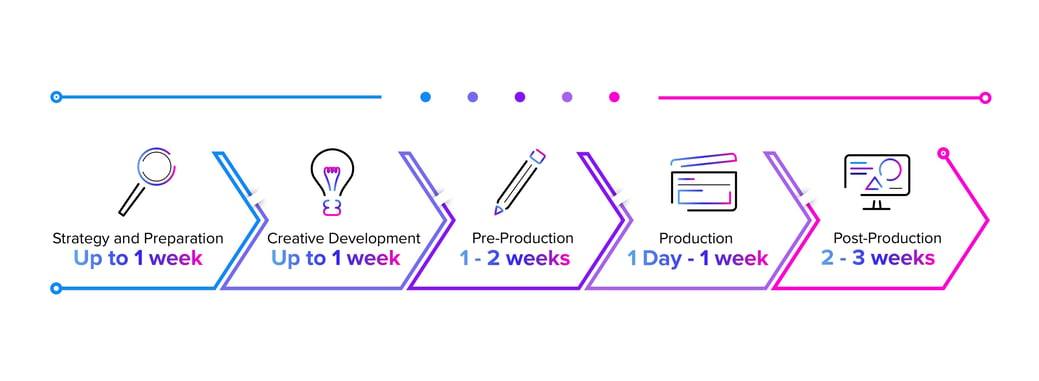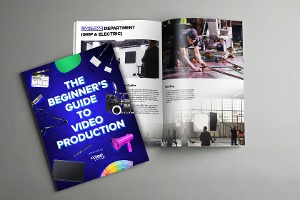There are some, okay a lot of projects in life where time and money are of the essence. Say remodeling a home (or watching someone do so on HGTV). When you watch a home renovation show, the questions you often hear the most are: how much will that cost me and when will it be done?
Well, the same goes for the video production industry. Generally, the first question people ask is: how much does it cost? The follow-up question is often: and how long will that take? Just like the cost of a video, the answer for the timeframe of producing a video from start to finish is the same: it depends.
In general, to produce a two-minute live-action marketing video that has interviews, b-roll (video that supports the narrative), and motion graphics text, the ideal amount of time to complete this would be four to eight weeks. Needless to say, the simpler the scope the quicker the timeline. Let’s break down what goes into that four to eight weeks.
What is the General Timeline for Producing A Marketing Video?
When it comes to producing video, there are 3 main phases: pre-production, production, and post-production. However, there’s still plenty of legwork that happens before pre-production. Below are the 5 segments that determine the timeline of creating a video, some of which happen simultaneously.
- Strategy and preparation = up to 1 week
- Creative development = up to 1 week
- Pre-production = 1 – 2 weeks
- Production = 1 day – 1 week
- Post-production = 2 – 3 weeks

Video Strategy and Preparation
To start, let’s rewind to the project contracting phase. Before production begins, a production company likes to sit down with the client (an intake meeting) to get an understanding of what they want out of the video – their goals. From there, to help outline a clear picture about the client’s project, the company puts together a creative messaging brief for the client to approve. It’s an integral part of the video project’s success and an easy way to stay organized and aligned.
In those briefs, the agency wants to get as much information as possible in order to develop the creative and the needed budget to make that happen. They’ll discuss things like will your video be narrative or interview-based; will it be shot on location or in a studio; will we need actors, voice talent, etc. All of these considerations will affect the timeline, but in general, this process can take about a week.
Once the agency has a better understanding of the scope of the project (the budget, timeline, goals, etc.), they’ll move into the creative development.
FREE DOWNLOAD: CREATIVE MESSAGING BRIEF
Creative Development
What is creative development? It’s the creative idea that brings your video to life. Choosing the right creative approach can be the most important part of producing an effective video. This can take a couple of days or, in an ideal world, a full week.
That timeline is condensed if the video is interview based. That’s because the creative approach doesn't need to be fully fleshed out, but encompasses what we know about the project goals, audience and core message. For example, the creative could be a training video that looks like a reality TV show or an interview-based video that’s shot like a documentary. Once the creative is decided upon, you’ll move into the next phase.
Pre-Production
There are many steps in this phase and the creative approach determines the timeframe associated with each step.
- Scripting
- Graphic design
- Hiring talent/pre-interviews
- Scouting locations and logistics
- Scheduling
- Shot lists
Scripting
Regardless of that creative approach, pre-production starts with the script. Writing the script, getting feedback, and making adjustments before getting it locked in place usually takes a week. If “legal” is involved on the client’s end, it can take longer.
FREE DOWNLOAD: VIDEO SCRIPT WORKSHEET
Graphic Design
If your video includes design and motion graphics (such as kinetic text), style frames will need to be created – examples of what the graphics and motion will look like. This can take anywhere from a couple of days to a week and can run somewhat concurrently with the scripts.
Hiring Talent/Pre-Interviews
If your production is narrative-based, you’ll need to hire professional actors, a process that includes holding auditions and making selects. To optimize your time on the day of the shoot, many agencies also do rehearsals ahead of time with those actors to help fine tune their performance.
If your video is interview-based, pre-interviews are held in a similar fashion: to fine tune the performance and make sure the needed content will be captured.
Scouting Locations and Logistics
Where you plan to shoot your video is something that’s determined in the creative development stage. Once you decide where that’s going to happen, you have to scout the right location. Your perfect location might require certain permits, so you’ll need to bank extra time to complete the proper documentation.
Scheduling
Once you have all of the above items ready to go, you’ll need to bring it all together and schedule your shoot. That requires finding a time that works for the client, on-air talent, production team, and shooting location.
Shot Lists
To ensure all assets are captured during your shoot days, the Producer and/or the Director of Photography (DP), will develop a shot list. Shot lists are especially important and helpful if you have multiple shoot locations or multiple interviews to conduct.
All of these steps can take a couple of weeks as well, and that just brings us up to the shoot date.
Production
Once everything is lined up, you’re ready to shoot. The number of shoot days will be determined by the items outlined in the creative development and pre-production. Some narration or interview-based videos only take one day to shoot. Some take five. For planning or pitching purposes, setting aside a week for production is a safe bet.
Post-Production
Once you’ve captured the visual assets of your video, you’ll move into post-production. Just like the pre-production phase, post-production includes several steps:
- Processing of footage
- Editorial with 2 to 3 revisions
- Voice-over casting and recording
- Motion graphics
- Color grading
- Audio
READ: WHAT IS POST-PRODUCTION AND HOW DOES IT ELEVATE YOUR VIDEO?
Processing of Footage
This depends on how the video was captured, the format and resolution, and how much footage was captured during the shoot; is your video a scripted narrative with multiple takes and multiple locations? A higher resolution, which increases the quality of the picture, will take longer to process and its speed is dependent on the computer system that it’s being downloaded to.
Editorial
Just like the script, there are multiple rounds of review of the video. Each round, or edit version, can take anywhere from 3 to 4 days to execute. However, that editorial may take longer if there are multiple interviews or your interviewee wasn’t good on camera. For example, the footage may be full of pauses, interruptions, and awkward phrasing which will increase the amount of time to cut it together into a cohesive piece.
Voice-over Casting and Recording
A voice-over may or may not apply to your video, but if it does, you’ll need to host auditions, hire professional voice talent, and record whatever narration is necessary.
Motion Graphics
If you included motion graphics in your creative development, it’s now time to bring those storyboards from the pre-production phase to life.
Color Grading
Once the picture is locked, the video is color-graded. You can think of color grading a video like editing the appearance of a still picture: increasing (or decreasing) the brightness, adjusting the contrast or saturation, or fixing exposure problems.

Audio
The final step of post-production takes sound design into consideration. This is where we mix and master the audio, which can include the narration, music, and sound effects. The sound design also takes the video’s final platform into consideration. Mixing audio for web is very different from mixing it for broadcast, which is also different for a live presentation. Because of this, care and time must be taken for each destination to ensure that the audio sounds appropriate.
For the two-minute marketing video we’re using as our baseline, two weeks is a safe bet for post-production.
Accessibility Considerations
Lastly, there’s finalization. This phase occurs AFTER a video is approved. Here you’ll address accessibility considerations, generate the closed captions and descriptive audio tracks, generate any subtitles that might be needed, localize to other languages (if needed), and do final QA (quality assessment) and export to the final deliverable files.
This process, depending on how many of the aforementioned requirements are needed, most commonly takes a couple of days to a week.
How Long Does it Take to Make a Video?
So, you can see how a timeline can grow pretty quickly. It is possible to knock out a full blown three-minute video with motion graphics, and on-location shooting with actors, in as little as three weeks, but to do that the cost would be substantially higher. Why? Four to eight weeks of work would have to be accomplished in three.
Remember, there are 5 segments you need to consider when determining a realistic timeline for your video project:
- Strategy and preparation = up to 1 week
- Creative development = up to 1 week
- Pre-production = 1 – 2 weeks
- Production = 1 day – 1 week
- Post-production = 2 – 3 weeks
When you’re planning your next live-action video, plan on four to eight weeks from the moment the contract is signed and the PO (purchase order) opens as a starting point, and then adjustments can be made based on the scope.
Learn more about video by clicking the image below to download the free eBook: The Beginner's Guide to Video Production.






